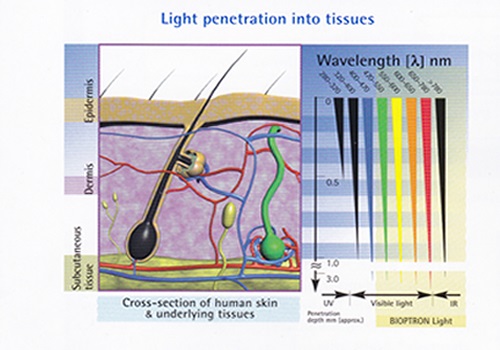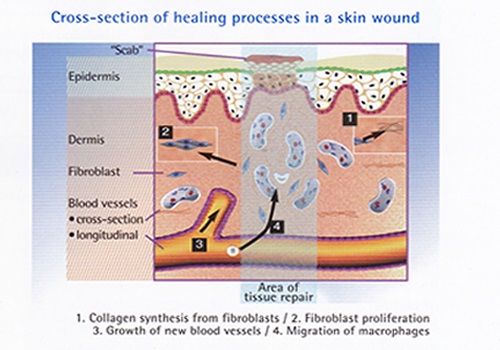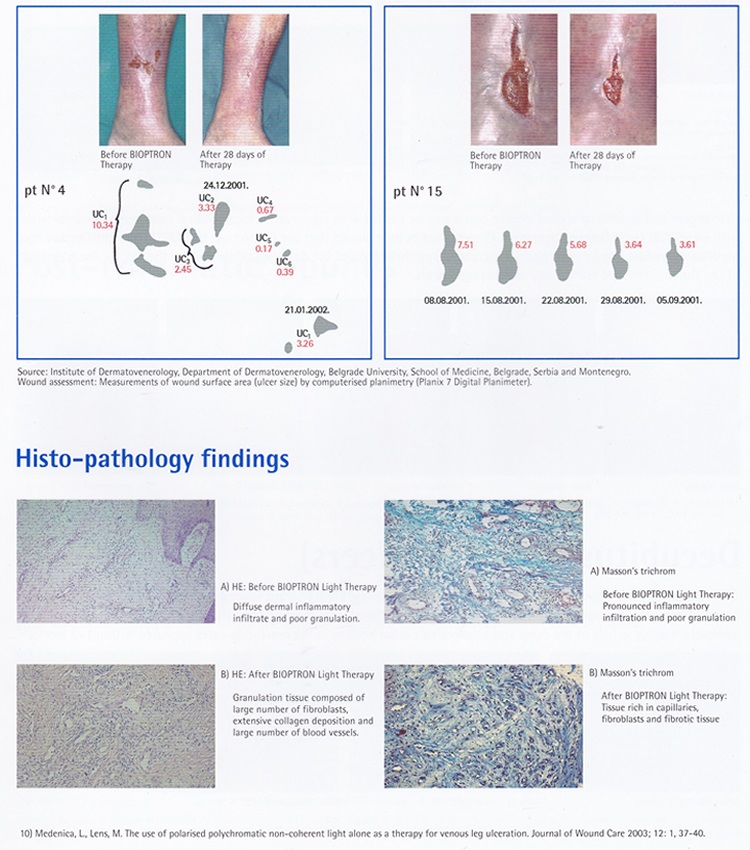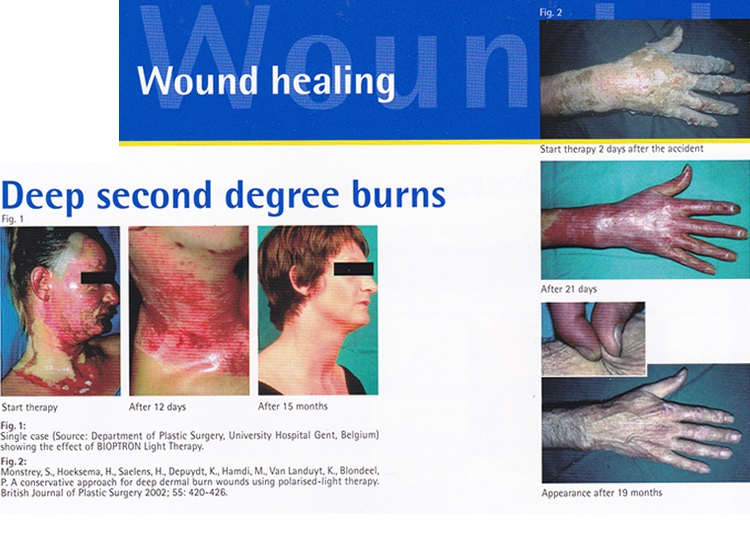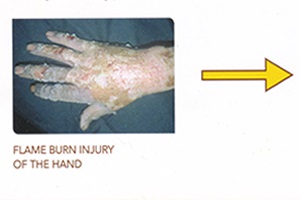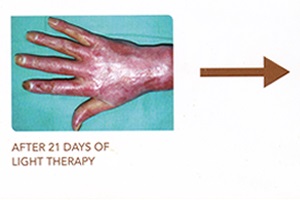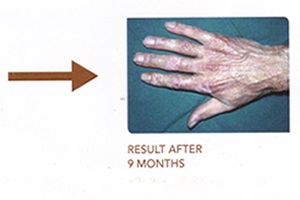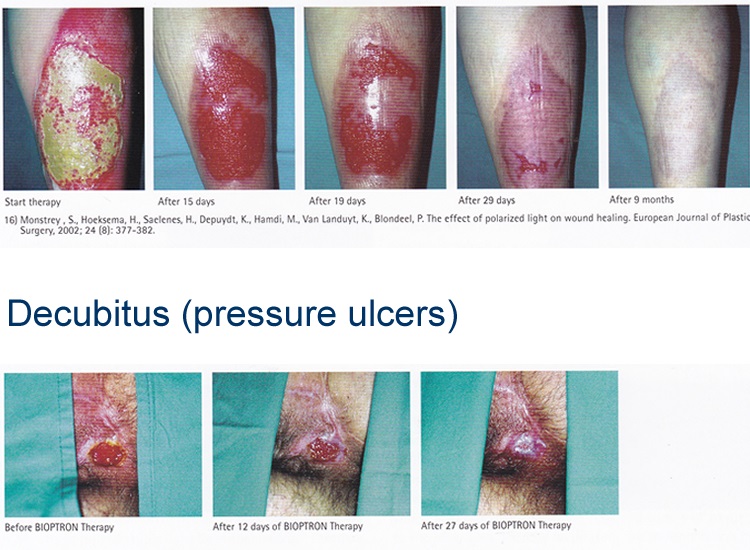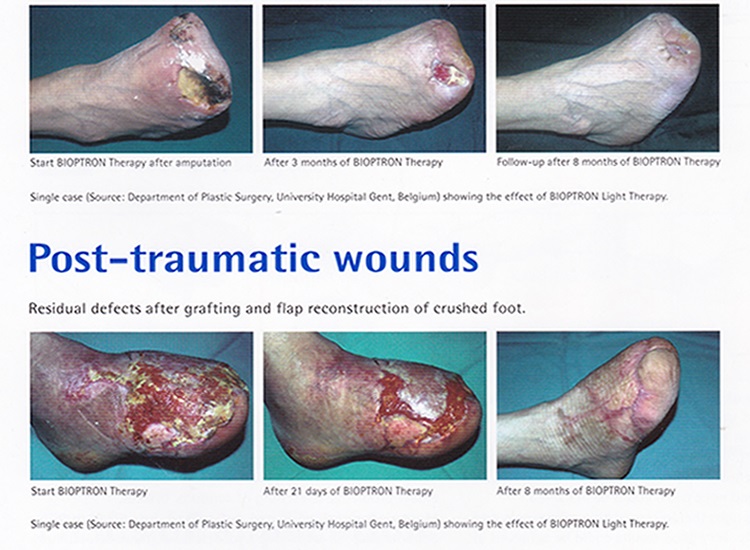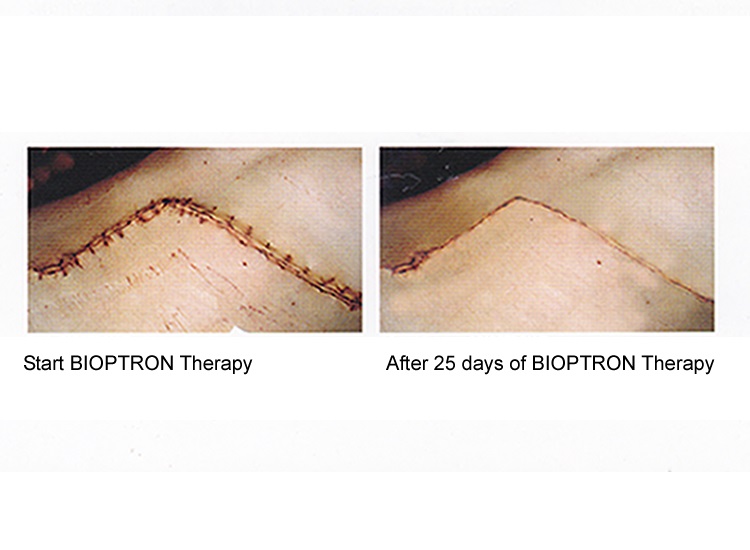





![]()
![]()
BIOPTRON LIGHT THERAPY
ACUTE AND CHRONIC WOUND HEALING
|
VIDEO
With Dr. Michael McNamara, M.D., Diagnostic radiologist, Monte-Carlo LifeCheck (R) The Principality of Monaco and Dr. Franco Coce, Prim Dr. med specialist internist & diabetologist, Zagreb, Croatia ‘BIOPTRON HEALS WOUNDS BETTER AND UP TO TWICE AS FAST, REDUCES PAIN, DISCOMFORT AND SCARS’ "The wound healing effects of BIOPTRON light therapy is undoubtedly associated with improvement of blood microcirculation, enhancement of the trophic function of blood, but also with increase of concentration in blood serum of growth factors and some cytokines" - Professor Samoilova, PhD, DSci, Prof International leader in Photobiology and Photomedicine. Read Professor Samoilova's full opinion on BIOPTRON In the area of wound healing, BIOPTRON Light Therapy can be used as a stand alone therapy and / or as a complementary - additional therapy for the treatment of:
Normal wound healing is a complex process consisting of different stages which are divided into three overlapping phases:
The process of wound healing requires the interaction of cells in the dermis (lower part of the skin) and epidermis (upper part of the skin) as well as the activity of chemical mediators (biochemical substances responsible for biological activities in the human body) released form inflammatory cells, fibroblasts and keratinocytes (specific cells playing a part in would healing). So BIOPTRON Light treatment can promote and speed up wound healing and lead to rapid regeneration of epithelium (skin tissues) in the edges and depth of a wound.
WOUND HEALING STASIS ULCERS (VENOUS LEG ULCERS) BURNS DECUBITUS (PRESSURE ULCERS) DIABETIC FOOT Chronic wounds are underestimated by physicians and general public alike, yet their prevalence continues to increase dramatically because of the steady growth of the elderly population and because the elderly at an increased risk in respect to chronic wounds. The need to care for the population with chronic wounds is a growing challenge that requires innovative approaches. We believe that the use of BIOPTRON Light Therapy and in conjunction with existing procedures could greatly enhance the natural wound-healing process. Furthermore, improved wound healing could reduce the risk of infection for the patient, decrease the number of costly dressings required, and more importantly return the patient to a pre-injury/illness level of activity. BIOPTRON Light Therapy Systems provide new insight into the management of venous leg ulcers, pressure ulcers, diabetic foot ulcers, burns, grafting and wounds following operation and injury. Patients are now able to receive innovative wound-care management. BIOPTRON Light Therapy could offer significant support in conjunction with standard wound-care.
Wound healing has a highly complex set of physiological processes regulated by many different cellular and humoral factors
© HAROMED BVBA - Harmum Vereecken - 2004. Source: Bolton, P., Dyson, M., Young.S. The effect of polarized light on the release of growth factors from the U-937 marcrophage-like cell line. Laser Therapy 1992; 33-37. The complex process of wound healing can be influenced by BIOPTRON Light Therapy. In spite of the positive clinical experiences reported in numerous publications, the mechanism of the biological effect of polarized light is still under investigation. It is assumed that, in the cell membranes, the polar heads of the lipid bilayer are reordered by polarized light and that, as a consequence, functional changes take place (3). Different biological effects have been observed after light therapy, including the stimulation of cell proliferation - especially fibroblasts, the release of growth factors and the enhancement of collagen synthesis. (3,4,5). A number of clinical studies have revealed accelerated wound closure with increased wound epithelization and improved tensile strength of scars. (4-7) One proposed mechanism of action of photostimulation is the absorption of visible light by mitochondria. (8) This may cause a chain of reactions on a molecular level, leading to an increase in cell energy and activation of the nucleic acid synthesis, which is essential in wound repair. The second proposed mechanism is related to the infrared portion of the light spectrum. This initiates the response at the membrane level, probably through photophysical effects on Ca++ channels (9). Light therapy has been shown to stimulate release of the growth factors from the irradiated cells. Growth factors stimulate angiogenesis, extracellular matrix production and degradation of cytokine release (10). The key cells in skin ulcer contraction and collagen synthesis are fibroblasts and keratinocytes. A number of studies have demonstrated their activation and proliferation in response to low-energy laser/photon stimulation. Other mechanism that may be responsible for the light's therapeutic effect is the local peripheral vasodilatation, which may enhance skin blood flow and supply of oxygen to the ulcerated area, thereby facilitating the transportation of the nutrients required for healing (10). Venous leg ulcers Leg Ulcers A leg ulcer is defined as a wound on the leg, below the knee that fails to heal within a 6 week period. Venous leg ulcers constitute the majority of all leg ulcers and are responsible for up to 80% of lower extremity ulceration's. An overall prevalence of venous leg ulcers ranges from 0.06% to 2.2% with a tendency to increase as the population ages. The prevalence of venous leg ulcers in patients after 70 years of age is estimated to be 1 to 4%. Venous leg ulcer refers to a failure of the venous system to return blood to the heart. This is usually caused by incompetent valves in the deep veins, the long saphenous vein, the short sphenous vein or the perforator veins of the calf which are situated in the leg. Due to the weak venous valves blood from the deep veins in the legs flows back into the minor veins (called the superficial veins) whereas the traffic should only be one way. This lads to a build up of blood in the superficial veins which will slow down and many eventually stop flowing. This may result in a metabolic breakdown particularly in the surrounding skin area and the skin may start to degenerate giving rise to inflammation and ultimately the development of an ulcer. Venous leg ulcers are difficult to heal and their complete healing may take years. Many patients with leg ulcers suffer from pain resulting in problems along with both sleep and mobility resulting in severe impairment in quality of life. The positive effect of BIOPTRON Light Therapy on the cells composing tissue in the leg region has been shown to enhance the healing process in patients with venous leg ulcers. BIOPTRON Light applied as a stand alone therapy has been shown to result in complete wound healing and or it can be considered effective in the treatment of venous leg ulcers when used as an integral part of a wound management programme. (9) It is widely known that light therapy can accelerate the healing of wounds and superficial skin ulcers (1,2) The favourable effect of BIOPTRON Light Therapy on the healing rate of venous leg ulcers may be explained by the stimulation of epithelial growth and granular tissue regeneration (10)
Upper photographs Source: Institute of Dermatovenerology, Department of Dermatovenerology, Belgrade University , School of Medicine , Belgrade, Serbia and Montenegro. Wound assessment: Measurements of wound surface area (ulcer size) by computerised planimetry Planix Digital Panimeter) Ref: (10) Medenica, L, Lens, M. The use of polarised polychromatic non-coherent light alone as a therapy for venous leg ulceration. Journal of Wound Care 2003; 12: 1. 37-40
BURNS Deep second degree burns
NOTE Fig 1: Single case (Source: Department of Plastic Surgery, University Hospital Gent, Belgium) showing the effect of BIOPTRON Light Therapy. Fig 2: Monstrey, S,, Hoeksema,, H., Salens, H, Depuydt, K., Hamdi, M., Van Landuyt, K., Blondeel, P.A. A conservative approach for deep dermal burn wounds using polarised-light therapy. British Journal of Plastic Surgery 2002; 55; 420-426 First-degree and superficial second-degree burns may be treated with conservative local medical treatments in combination with BIOPTRON Light Therapy treatment. Clinical studies have shown that the routine use of BIOPTRON Light Therapy may significantly reduce the time necessary for complete epithelization of the damaged skin, reducing the risk for the formation of the functionally and esthetically unacceptable scars (11) Severe Second Degree Burns BIOPTRON Light Therapy has been used in the treatment of burns for many years and the treatment of burns depends on the depth and severity of the injury. A standard classification results in precise treatment such as conservative or surgical intervention. First Degree Burns are the mildest form A good example is sunburn. First degree burns are normally characterized by reddening of the skin, slight swelling and pain and discomfort. The symptoms normally disappear within a few days without leaving any scars. Second Degree Burns are called partial thickness burns and are divided into superficial and deep burns. In the superficial second degree burn the entire epidermis (upper part of the skin) and a superficial part of the dermis (the lower part of the skin) are destroyed. Since the depth of the burn is relatively superficial there are usually no long term effects to the skin hair follicles, sweat glands or nerve endings. Usually the damaged skin regenerates with two weeks after the injury. Deep Second Degree Burns are more serious. There is generally damage to the deep layer of the dermis with only a few hair follicles, sweat glands and nerve endings remaining at the base of the wound. These wounds require surgical removal of dead tissue and transplantation of skin - skin grafting. More than 50% of burns are deep second degree burns or full dermal burn wounds. Third Degree burns (full thickness burns) are where all of the layers of the skin are destroyed leaving no possibility for the injury to heal naturally unless the burn covers a very small area and require surgery. The major complications of such wounds are infection, development of scars and contractures. BIOPTRON FOR FIRST DEGREE AN SUPERFICIAL SECOND DEGREE BURNS These burns can be treated with conservative local medical treatment approaches in combination with BIOPTRON Light Therapy. Several studies have shown that the routine use of BIOPTRON Light Therapy can significantly reduce the time necessary for complete epithlisation (regeneration of the skin) towards complete healing thereby effectively reducing the formation of scaring. Clinical findings show how the application of pressure therapy can start earlier if the burn area has been treated with BIOPTRON Light Therapy. In addition if the body area (save for the hands) are treated with BIOPTRON Light Therapy then physiotherapy can begin immediately. 2ND DEGREE BURNS BIOPTRON Light Therapy has been used to treat patients with deep second degree burns after surgical procedures have been carried out to reduce healing time and time in hospital.
Decubitus - pressures sores commonly referred to as a bedsore and this form of pressure ulcer is caused by prolonged pressure on specific body areas in patients confined either to bed or wheelchair. They tend to develop on an area of the body where bony prominence is not protected by muscle tissue such as the sacrum (the tailbone at the base of the spine), heels, elbows and shoulder blades. When the pressure cuts off the blood supply cells and tissues composing the skin are damaged and ulcers start to form creating a potential breeding ground for harmful bacteria with increasing infection. One in ten hospital patients, one in eight home care patients and one in four nursing home patients suffer from bedsores. The problem is seen to be growing due to the ageing population and in every hospital the number of patients requiring treatment for bedsores is increasing creating high levels of demand on resources and funding. Treatment involves taking pressure off of the body area requiring high levels of nursing and healthcare provision. The pressure ulcers are cleaned although in some cases the use of surgical intervention is required. BIOPTRON Light Therapy has been shown to be an effective therapy to accelerate tissue healing and repair. Clinical studies have demonstrated the effectiveness of polarized light therapy in healing 1st, 2nd and 3rd grade pressure ulcers. When polarized light treatment was added to conventional ulcer therapy, rapid changes in appearance and size with complete healing in half of the cases and accelerated partial healing in the remaining cases appeared within 1-2 weeks (13) Above images Source Single case Department of Plastic Surgery, University Hospital Gent, Belgium. Showing the effect of BIOPTRON Light Therapy. BIOPTRON Light Therapy also play an effective role in the prevention of bedsores. Diabetic foot ulcers BIOPTRON Light Therapy has been used to treat diabetic foot ulcers and clinical results have confirmed its positive influence on the affected and treated areas. The ulcers gradually cleared, granulated and epithelized during treatment. Healing time was substantially shortened and ulcer pain was lower compared to treatment without BIOPTRON light therapy application (17).
Post surgical wounds BIOPTRON Light Therapy is a very simply and effective additional therapy in treatment of surgical wounds.
19. Simic, A., Peskin, P., Bjelovic, M., Stojakov, D., Todorovic, M., Jekic, I., M icev, M., Sabljak,P., Kontarak, M., Bioptron Light Therapy and Thoracoprenolaprotomy wound healing in patients operated due to cardiac carcinoma. Presented at the 4th International Gastric Congress, New York, USA. April 30 -May, 2001 Chronic wounds are frequently encountered in the elderly and those who are bedridden. Typical characteristics of chronic wounds include a loss of skin or underlying tissue and failure to heal with conventional types of treatment. Chronic wounds are difficult to heal and require a long time to complete closure. The relative resistance of chronic wounds to a wide range of therapeutic approaches and the absence of a standard single therapy for the treatment of chronic wounds shifted the attention of many researchers towards the investigation of other therapeutic approaches. The use of different sources of light therapy in wound healing therapy has gained particular attention in the last few decades, and many clinical studies have evaluated the role of light therapy in the management of wounds. BIOPTRON Light Therapy can promote and speed up wound healing through the stimulation and modulation of reparative and regenerative processes, anti-inflammatory effects and enhancing processes of the human defense system. This type of phototherapy can be considered a valuable therapy in the treatment of various wounds and would healing disorders.
|

For further information & ordering - please email steven@lighttherapyuk.com





![]()
![]()
![]()
![]()
![]()
© Steven Warren - Light Therapy UK. All rights reserved 2005 - 2018

